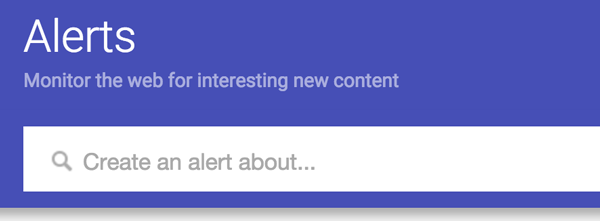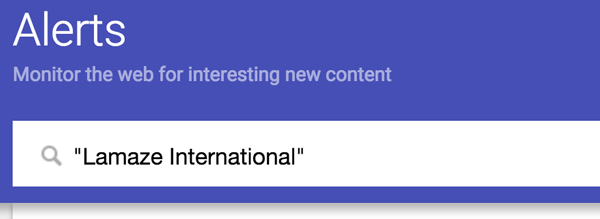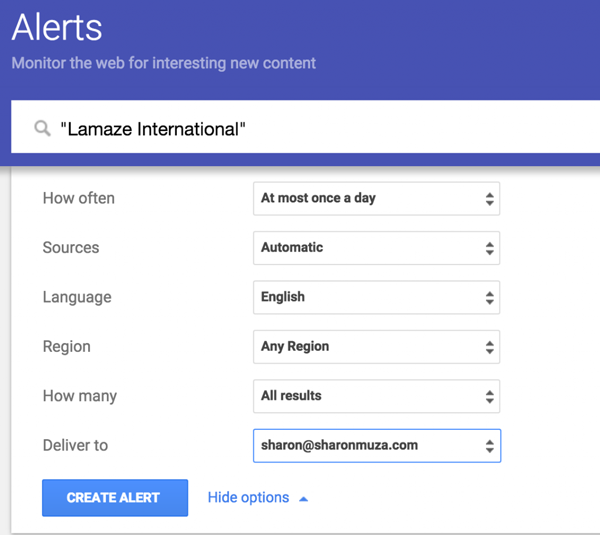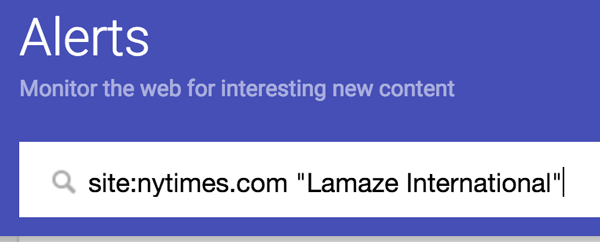Series: Building Your Birth Business - Using Google Alerts
By: Sharon Muza, BS, LCCE, FACCE, CD/BDT(DONA), CLE | 0 Comments
 At times, the internet can feel like a very large place. The amount of information available to us at any one time almost seems too much and too big to handle. As a birth professional who writes and teaches on the topics of pregnancy, childbirth and postpartum, staying up to date with news and information feels simply too overwhelming most of the time. So many websites, so much new research, so many interesting blog posts and all of it is of interest to me. I don't want to miss a thing, but poking around the world wide web often results in going down too many rabbit holes, easily getting led off track and a significant loss of productivity and often a waste of time.
At times, the internet can feel like a very large place. The amount of information available to us at any one time almost seems too much and too big to handle. As a birth professional who writes and teaches on the topics of pregnancy, childbirth and postpartum, staying up to date with news and information feels simply too overwhelming most of the time. So many websites, so much new research, so many interesting blog posts and all of it is of interest to me. I don't want to miss a thing, but poking around the world wide web often results in going down too many rabbit holes, easily getting led off track and a significant loss of productivity and often a waste of time.
Google Alerts
Establishing Google Alerts is an effective and efficient tool to help me stay on top of the news I want to hear about. Even more useful is the fact that this information can be delivered directly to my inbox. Google Alerts lets me specify the search terms I am interested in. After setting up my alerts and customizing them to my preferred frequency, search sources and delivery method, I sit back and wait for Google to email me a digest with links to all the news that is related to my search terms.
How to set up a Google Alert
Let's say that I would like to be made aware of any current news that contains the phrase 'Lamaze International.' Here are the steps to get your alert set up.
In your favorite browser, go to the Google Alerts page. You do need to be signed in to a Google account.

In the 'alert' bar, type in the word or phrase that you want to be alerted about. If it is a phrase that has two or more words together, you will want to be sure to put quotation marks around the phrase so that Google looks for them together. Putting search phrases in quotes can help you more clearly drill down to the information that you will find helpful.

Next, you have the option of choosing how frequently you would like to receive the alert, (I like to receive them daily), the sources that Google should search (I choose News, Web, Blogs), the language that should be searched (for me, English), the region to search (I select any, but you can be more specific), and whether I want only top results or all results (I prefer all.) I also indicate which email to send the results to.

If you find that your search terms or specified options are not working for you, you can always go back and edit them to refine the results. Editing is very easy. Return to the Google Alert page and select the pencil next to the alert you want to edit. If you have tried to edit for better results and are still finding the alert not satisfactory
In addition to the topics you are interested in, you might consider setting up alerts for your business name, your website URL (don't use the www) and your personal name. This is a great way to keep tabs on who might be linking to your site or what people are saying about you or your business. Remember to put quotation marks around phrases that you want found together, for example 'Sharon Muza'. If there are common misspellings of your name or your business, you might consider setting up alerts for those misspellings too. When you find yourself mentioned online, if it is positive, you can thank the writer and if there is a concern you are able to deal with it promptly.
Consider setting up Google Alerts for your competitors, so you can keep a keen business eye on what your competition is doing. This may create opportunities for you and help you to better understand your competition.
You can tell Google Alerts to search just a specific website for the term you are interested in. Let's say I wanted to know when The New York Times posts something Lamaze International. I set up the alert like this:
This tells the alert to regularly scan the domain nytimes.com for the phrase 'Lamaze International'.

Having a robust set of alerts means I have many suggestions for items to cover on this blog or on my own personal blog. A great resource when my creativity has flown the coop.
If you are feeling overwhelmed with the number of email alerts coming in to your inbox, consider making a rule in your email program that directs them to an 'alert' folder that you can pay attention to when time allows. Alternately, you can use an email that you set up just for your alerts, and check that inbox when you are able.
Google Alert results
The results for my VBAC Google Alert look something like this:

Once you become familiar with how Google Alerts works, you can explore more parameters to include or exlude specific terms. For example, while I am interested in Lamaze, I am not interested in Eric Lamaze, a well known international equestrian. I can tell Google Alerts not to show me anything with 'Eric' by putting -eric in my alert field.
Alert possiblities
Some of the alerts that I have set up include:
- Lamaze International
- Science & Sensibility
- Childbirth Class
- Birth Class
- VBAC
- Cesarean
- ACOG
- and many, many more. You can have 1,000, so I still have room to grow!
The possibilities are endless.
Resources for more information
Here are some additional resources to learn more about using Google Alerts
Google Alerts Help
How to Create a Google Alert - About.com
YouTube Tutorial on Setting Up Google Alerts
How to Create Google Scholar Alerts - Free Technology 4 Teachers (note: Google Scholar is a great place to find scientific papers and published research. Very, very useful!)
Do you use Google Alerts? How have you found it helpful? Do you have some tips to share? If you are new to Google Alerts, after reading this post, do you think you might be open to trying some? If so, come back and let us know how it is working for you.
Published: December 09, 2015
Tags
Childbirth educationResearchProfessional ResourcesSeries: Building Your Birth BusinessGoogle Alerts